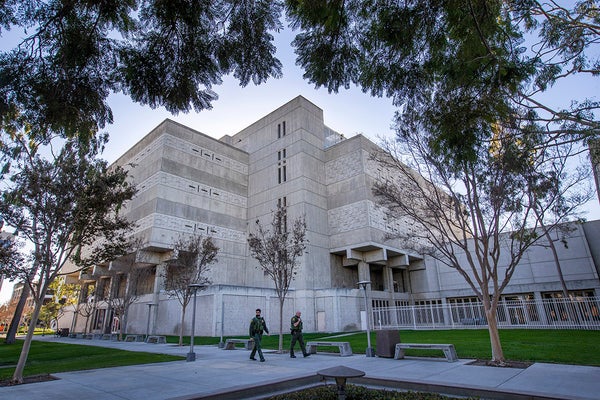COVID fundamentally altered how states administer justice. Arrests dropped, and prisons nationwide released inmates on an expedited basis.
Perhaps nowhere was this last change more evident than in California. To stem COVID outbreaks, the state released thousands of individuals incarcerated in its jails and prisons. Immediately, critics voiced concern about the impacts of these releases on crime rates.
Three years later, we can answer the question: How were COVID downsizing measures and crime trends related? In a newly published study, we show there is little connection. These results, and others like it, suggest that reducing the number of people incarcerated won’t compromise public safety.
On supporting science journalism
If you're enjoying this article, consider supporting our award-winning journalism by subscribing. By purchasing a subscription you are helping to ensure the future of impactful stories about the discoveries and ideas shaping our world today.
Even before the pandemic, California had downsized its prisons and jailsthrough a series of reforms intended to reduce the state’s massive population of people in prison. They worked. California has reversed course when it comes to incarceration. In 2009, two years prior to the first reform, the state’s incarceration rate was 329 per 100,000 residents. In 2019, after the reforms, the rate dropped to 290. These early moves did not harm public safety. Instead, research found downsizing measures had no impact on violent crime and only marginal impacts on property crime statewide.
The pandemic furthered California’s trend in decarceration, as the state downsized yet again to slow the virus’s spread. Release actions this time led to a population reduction of around 30,000—or 23 percent of California’s in-custody population—in the first year of the pandemic alone. To put it into perspective, in terms of month-to-month proportionate changes, California’s efforts to reduce overcrowding as a means to limit the spread of the virus reduced the number of incarcerated people more severely and abruptly than any of the state’s modern reforms.
Critics were quick to suggest that upticks in crime in California were an inevitable consequence of pandemic downsizing measures. They pointed to a troubling increase in violent crime, particularly homicide, as cause for concern. Indeed, the year 2020 saw an increase of more than 500 homicides in California, the largest jump in state history since record-keeping began in 1960.
But a lot was going on in the pandemic. Figuring out how pandemic-related downsizing may have changed crime rates is no easy task. Parsing decarceration’s possible impact from any other factor during one of the most dynamic and challenging periods this state—and the nation as a whole—has experienced is challenging to say the least.
We took up this challenge. In our study, we adopted a quasi-experimental approach to estimate the impact of COVID-mitigating jail decarceration on crime in California. We examined both downsizing and crime in the state’s 58 counties; the counties differed in decarceration amounts, ranging from less than a 1 percent reduction in upper northeastern Lassen County to a 43 percent reduction in Imperial County located in the state’s southern tip. This natural variation allowed us to isolate decarceration’s impact from various other shocks affecting the state as a whole.
Overall, we identified six counties (what we call our treated unit) that experienced the highest dosage of decarceration based on their proportionate change in county jail populations from the year prior to the year following the March 2020 lockdowns. We next constructed a comparison unit, composed of a combination of counties that had the lowest decarceration rates during the pandemic. Any gap in crime that emerges between the treated (highest-dosage) and comparison (lowest-dosage) counties following decarceration could be attributed to the jail downsizing treatment effect. In other words, the comparison unit approximates what would have happened to crime had the state not downsized its jails. If jail decarceration during COVID-19 caused crime to increase, then across the six highest-dosage counties we would expect to consistently see the comparison unit fall below the treated series.
This did not happen. Instead, we found that for both violent and property crimes, the outcomes were not uniform, with some counties showing an increase in crime resulting from high-dose jail decarceration, others showing a null impact, and still others showing a reduction in crime because of high-dose jail decarceration. In short, the relationship between decarceration and crime appears weak and inconsistent—not significantly connected as many claimed.
The primary limitation of our approach is that the treated (high-dosage decarceration) counties and comparison (low-dosage decarceration) counties do not reflect fully treated and completely untreated versions of county crime rates generally considered ideal for this method. Rather, they reflect a high-dosage treated unit and a low-dosage comparison unit. We thus stop short of producing stark numeric estimates in the analysis and focus, instead, on the overall pattern of results. Even so, the lack of a consistent relationship between jail decarceration and crime in California counties suggests that downsizing during the pandemic did not, on average, drive upticks in crime statewide.
These results are not terribly surprising. California’s crime trends during this period reflected broader trends nationwide, raising further doubt that COVID-19 downsizing measures are to blame for rising crime. Researchers examining crime rates in 34 U.S. cities found that homicide rates were 30 percent higher in 2020 compared with the year prior—an historic increase—even as they remained well below peak rates in the early 1990s.
In the words of one research team: “The pandemic created rare natural experiment research conditions that enable unique and potentially valuable insights … that may indicate future justice practices and policies.” The valuable insight from our study is knowing that we can downsize our prisons and jails without seeing crime rates skyrocket.
This is an opinion and analysis article, and the views expressed by the author or authors are not necessarily those of Scientific American.
